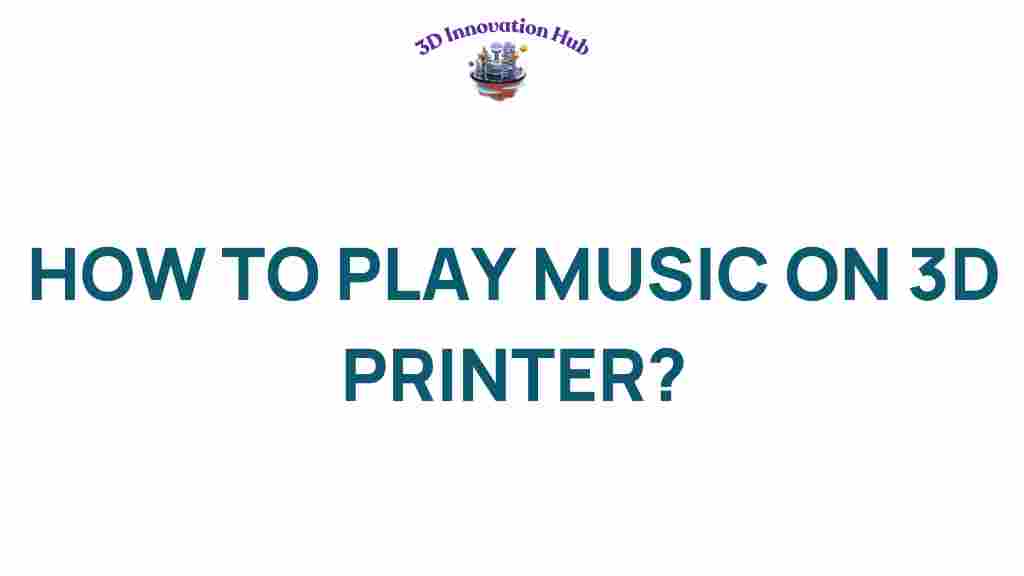3D Printer: Music, Creativity, and the Intersection of Technology
In an era where innovation drives creativity, the fusion of technology and art has paved the way for exciting DIY projects. One such captivating project is using a 3D printer to create music. This article will explore how you can unlock your creativity by playing music on your 3D printer, turning your machine into a unique sound generator. Whether you’re a seasoned maker or a curious beginner, this guide will help you understand the steps involved, the technology behind it, and how you can embark on this innovative journey.
Understanding the Concept
The idea of using a 3D printer to produce music may sound unconventional, but it’s a remarkable demonstration of how technology can be leveraged for creative expression. By manipulating the movements and functions of your printer, you can generate sound in various ways. The process involves programming your printer to play notes through its motors, creating a symphony of mechanical sounds.
Benefits of Combining Music and 3D Printing
- Enhances Creativity: Engaging in projects that merge different disciplines fosters an innovative spirit.
- Educational Value: This project teaches about sound production, programming, and the mechanics of 3D printing.
- Unique Outputs: Each project can yield different musical results, making every attempt a new experience.
- Community Engagement: Sharing your creations can inspire others and build connections within the maker community.
Step-by-Step Guide to Playing Music on Your 3D Printer
Now that we’ve set the stage for understanding the intersection of 3D printing and music, let’s dive into the step-by-step process to create your own musical masterpiece.
Step 1: Gather Your Materials
Before you start, ensure you have the following materials:
- 3D Printer: Any standard 3D printer capable of executing G-code.
- Computer: For programming and uploading files to the printer.
- Software: A music software (like MIDI editor) to create your sound sequences.
- G-code Generator: Software that can convert music into G-code commands.
Step 2: Create Your Music
Begin by composing a simple melody using your preferred music software. You don’t need to be a professional musician; even basic tunes will work well. Export your composition as a MIDI file, which can be translated into G-code.
Step 3: Convert Music to G-code
Utilize a G-code generator that can interpret the MIDI file into commands your 3D printer can understand. There are various online tools and software options that can help with this conversion. Ensure your output matches the movement capabilities of your printer to avoid any issues during playback.
Step 4: Prepare Your 3D Printer
Before starting the print, prepare your 3D printer:
- Check Settings: Ensure your printer is calibrated and properly set up for the type of project you’re undertaking.
- Load the G-code: Upload the generated G-code file to your printer using the appropriate method (SD card, USB, or direct connection).
Step 5: Play the Music
With everything set, initiate the print job. As your 3D printer operates, it will replicate the movements dictated by the G-code, producing sound as it goes. The result is a fascinating blend of technology and art!
Troubleshooting Tips
While the process is generally straightforward, you may encounter some issues along the way. Here are some troubleshooting tips to ensure your musical project runs smoothly:
Common Issues and Solutions
- Printer Not Responding: Double-check the connection between your printer and computer. Ensure the correct G-code file is uploaded.
- Poor Sound Quality: Review the G-code generation settings. Some settings may need adjustment for better sound output.
- Unexpected Stops: Monitor your printer during the playback. If it stops, inspect for mechanical issues or software glitches.
Further Resources
For additional help, consider exploring forums and communities dedicated to 3D printing and music production. Websites like Thingiverse can be excellent places to find tips and share your creations with others.
Conclusion
Unlocking creativity through innovative projects is what the maker movement is all about. By combining a 3D printer with music, you not only enhance your understanding of technology but also express your artistic side in unique ways. Whether you’re a hobbyist looking for a fun project or an experienced maker eager to explore new territories, playing music on your 3D printer is a fantastic way to innovate and create.
Now that you know the steps, it’s time to gather your materials and start your musical journey. The intersection of technology, creativity, and innovation awaits you, so get started on your own DIY project and let the sounds of your 3D printer inspire your creative vision!
This article is in the category and created by 3D Innovation Hub Team

1 thought on “Unlocking Creativity: How to Play Music on Your 3D Printer”